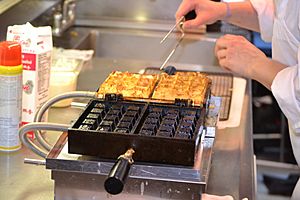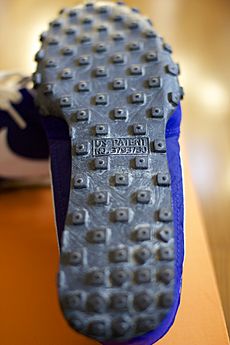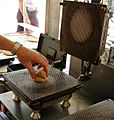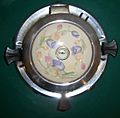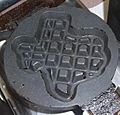Waffle iron facts for kids
A waffle iron or waffle maker is a kitchen tool or appliance used to cook waffles. It has two metal plates connected by a hinge. These plates are shaped to create the special honeycomb pattern you see on waffles.
You heat the iron, then pour batter or place dough between the plates. When you close the plates, the waffle bakes. Waffles are a sweet treat, much like pancakes but often lighter and sweeter. The waffle iron helps make their unique shape.
Contents
Types of Waffle Irons
Old and New Waffle Makers
Long ago, waffle irons were attached to tongs with wooden handles. People held them over an open fire or placed them on a stove.
Most modern waffle irons are electric. They sit on a tabletop and are heated by an electric element. A thermostat controls the heat.
Different Plates and Materials
Electric waffle irons can have plates that you can remove or plates that are fixed. Professional waffle makers are usually made of strong, uncoated cast iron. Waffle irons for homes, especially those made of cast aluminum, often have a non-stick coating like Teflon. Many irons have a light that turns off when the iron is hot enough to use.
Waffle Shapes and Sizes
Modern waffle irons offer many choices for waffle shapes and thicknesses. Some make very thin waffles, perfect for making waffle cones or Pizzelle. There isn't one official standard for waffle shapes. However, models that make common shapes are often called "traditional" or "classic."
Irons that make thicker waffles with bigger pockets are often called "Belgian." In the US, a "Belgian waffle" usually means a waffle that is thicker or has larger pockets. The recipes for Belgian and American waffles can also be different.
The History of Waffle Irons
Early Waffle Makers
The first waffle irons appeared in the Low Countries (like Belgium and the Netherlands) around the 1300s. These early irons had two hinged iron plates. They were connected to two long, wooden handles. The plates often had fancy designs. These designs could include family symbols, landscapes, or religious symbols. People baked waffles over a hearth fire.
New Inventions and Popularity
In 1869, an American named Cornelius Swartwout received a patent for a stove-top waffle iron. Waffle irons had been around for centuries. But Swartwout wanted to make them better. He added a handle and a hinge that could turn in a cast-iron ring. This made it safer to flip the iron without it slipping or causing burns.
In 1891, John Kliembach, a German immigrant, started selling waffles. He made an iron for a hotel in Shamokin, Pennsylvania. Kliembach sold waffles for a penny each. He sold a dozen for ten cents. His waffles were very popular at the Chicago World's Fair.
In 1911, General Electric created a test version of an electric waffle iron. They started making them for sale around 1918. As electric waffle irons became more common, their design also improved.
The Waffle Iron and Nike Shoes
In 1971, Oregon track coach and Nike Co-founder Bill Bowerman had a clever idea. He used his wife's waffle iron to try out different types of rubber. He wanted to create a new sole for track shoes. This new sole needed to grip well but also be very light. This would help runners go faster.
The track at Oregon's Hayward Field was changing to an artificial surface. Bowerman wanted a sole that could grip grass or bark dust without needing spikes. He was talking about this problem with his wife over breakfast. That's when the waffle iron idea came to him!
Bowerman's design led to the "Moon Shoe" in 1972. It was called that because its waffle-like tread looked like the footprints left by astronauts on the moon. Later, they improved the design even more. This led to the "Waffle Trainer" in 1974. This shoe helped the company, then called Blue Ribbon Sports/Nike, grow very quickly.
Images for kids
-
A waffle iron used to make stroopwafels in Nijmegen
-
A waffle iron shaped like Texas, often found in motels there
See also
 In Spanish: Gofrera para niños
In Spanish: Gofrera para niños



